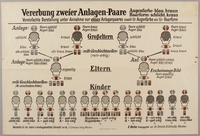Overview
- Brief Narrative
- Teaching placard for use in a racial studies class, published by J.F. Lehmann of Munich, a publishing house noted for producing books on eugenics.
- Artwork Title
- Rassentypen Europas und Seiner Grenzgebiet
- Alternate Title
- Racial types of Europe and its borders
- Series Title
- Placard I, from the series, Wandtafeln fuer den rassen-und vererbunskundklichen untericht Reihe I
- Geography
-
publication:
Munich (Germany)
- Credit Line
- United States Holocaust Memorial Museum Collection
- Contributor
-
Publisher:
J. F. Lehmanns Verlag
Author: Bruno K. Schultz
- Biography
-
Dr. Bruno Kurt Schultz (1901-1997) was born in Sitzenberg, Austria-Hungary (now Sitzenberg-Reidling, Austria). He earned a doctorate in physical anthropology and his work extended into the fields of heredity, ethnology, and anthropometry. He was the author of several books and many articles about anthropometry and racial hygiene. He lectured on these topics in Vienna, Austria, and in Munich and Berlin, Germany. In 1929, Dr. Schultz became a German citizen, and began working as editor at the J. F. Lehmann publishing house in Munich, which was known for producing medical literature, charts, and material about eugenics. In 1932, Dr. Schultz joined the Nazi Party. He was in the Schutzstaffel (SS), and worked in the Rasse- und Siedlungshauptamt-SS (SS Race and Settlement Main Office; RuSHA). While working there, Dr. Schultz developed the criteria that defined the physical characteristics that determined who in German society was considered “racially pure” and “Nordic.” His model was also used to determine who was eligible to join the SS based on their ancestry, the color of their hair, eyes, and skin, and other aspects deemed “racially pure.”
Following the German invasion and occupation of other nations just before and during World War II (1939-1945), the same general model was used to analyze populations for resettlement and Germanization within those territories. In February 1942, Dr. Schultz was appointed Chief of the Race Office (RuSHa), a position he held until the end of the war in May 1945. Dr. Schultz went through what the allied powers called denazification: the effort to remove all traces of Nazi ideology, institutions, influence, and laws from Germany, as well as Nazi party members from offices or positions of responsibility. He was not prosecuted as a war criminal. In the Nuremburg Doctors’ Trial (1946), other doctors were presented as manipulated by the SS and various Nazis, and were not considered affiliated with the concentration camps or killing centers. Instead, the SS and medical personnel, such as Dr. Mengele, who were directly involved with the camps and centers, were identified as those most responsible for the atrocities.
Physical Details
- Language
- German
- Classification
-
Posters
- Category
-
Nazi propaganda
- Object Type
-
Posters, German (lcsh)
- Physical Description
- Rectangular paper chart on linen backing.
- Dimensions
- overall: Height: 57.000 inches (144.78 cm) | Width: 41.750 inches (106.045 cm)
- Materials
- overall : paper, ink, linen, adhesive
Rights & Restrictions
- Conditions on Access
- No restrictions on access
- Conditions on Use
- No restrictions on use
Keywords & Subjects
Administrative Notes
- Legal Status
- Permanent Collection
- Provenance
- The chart was acquired by the United States Holocaust Museum in 1991.
- Record last modified:
- 2023-07-27 15:36:34
- This page:
- https://collections.ushmm.org/search/catalog/irn5593
Download & Licensing
In-Person Research
- By Appointment
- Request 21 Days in Advance of Visit
- Plan a Research Visit
- Request to See This Object
Contact Us
Also in Nazi Germany racial science and education collection
The collection consists of a textbook and Nazi racial science educational charts.
Date: approximately 1935

Large wall chart with photos used to teach racial hygiene in Nazi Germany
Object
Teaching placard for use in a genetics class, published by J.F. Lehmann of Munich, a publishing house noted for producing books on eugenics.
Book
Object



